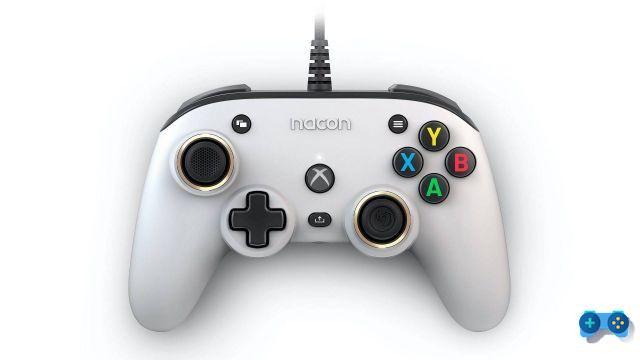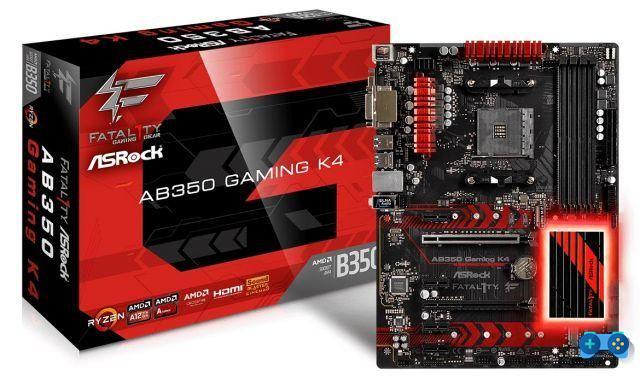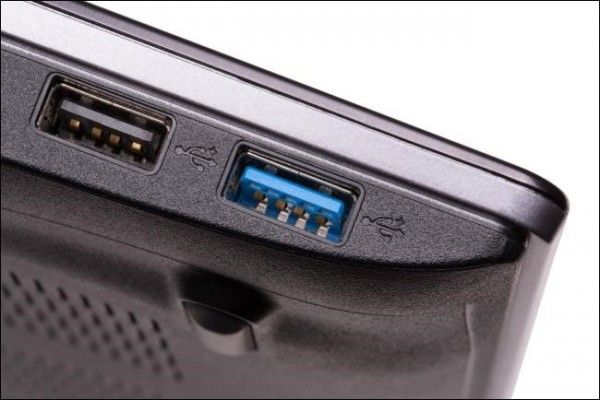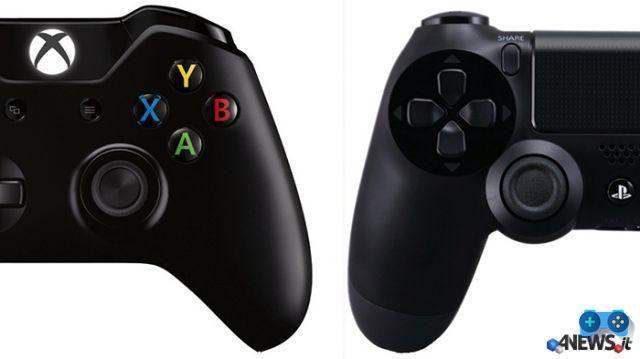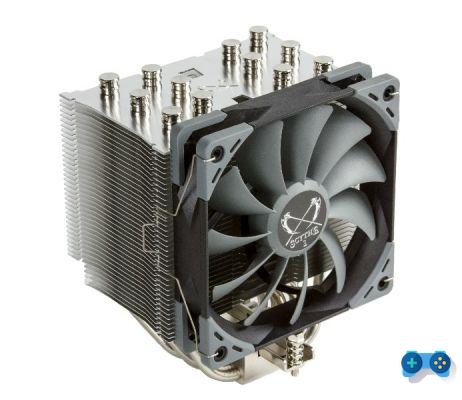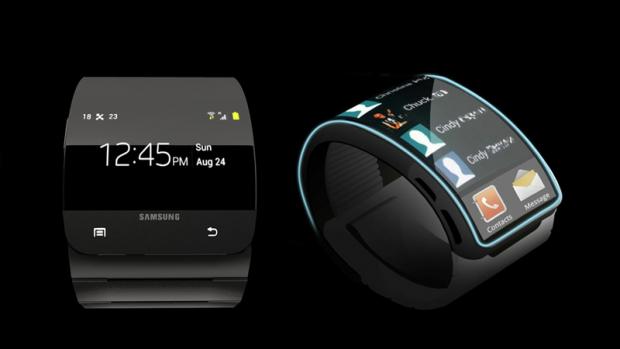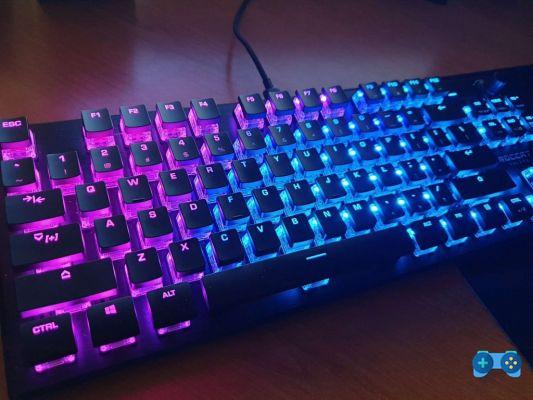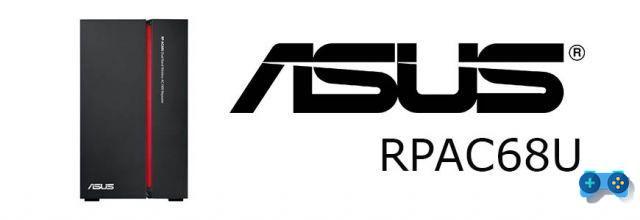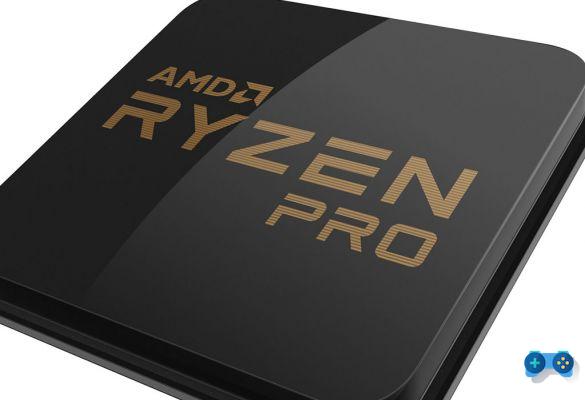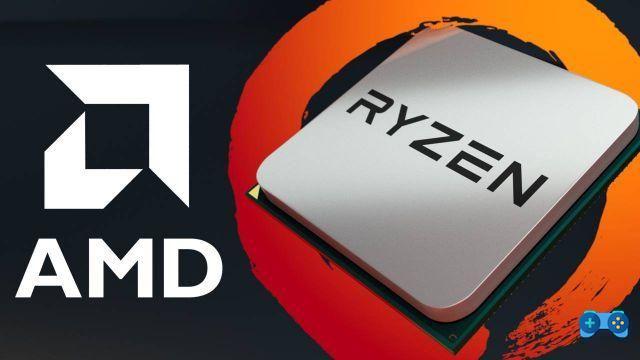
Introduction: Once upon a time there was AMD
With its Ryzen platform, AMD has returned to shuffle the cards of a steady market. In this Ryzen 1800X review we will try to explain how Ryzen works and why Ryzen 7 processors are the best CPUs for your setups, whether they are dedicated to gaming or productivity.
There are also stories in the cold world of hardware that we like to tell, like that of Apple, which was pushed to the brink of bankruptcy by an incompetent management, thanks to the newly found Steve Jobs and that iPod that would forever change our way of listening to music, has become the most capitalized company in the world, or that of PlayStation 3, which almost crushed by the outsider XBOX 360, a few years later took its revenge, literally tearing up the opponent in terms of sales.
This could be one of those stories.
The duopoly AMD / Intel in the world of CPUs it has always guaranteed users great competitiveness both in terms of performance and purely economic terms with competitive prices and significant technological increases from generation to generation. This at least up to a certain point, when, thanks to some perhaps too risky technological choices, the shining star of AMD began to blur.
The last great commercial success of AMD dates back to more than a decade ago, when the legendary series of processors Athlon, represented a highly competitive alternative in terms of performance and above all in economic terms Pentium by Intel. At the end of 2005, thanks to the extraordinary success of the Athlon processors, the Sunnyvale company recorded exceptional profits and above all a public confidence that swayed Intel's granite certainties.
The arrival of the platform Bulldozer and then of VisheraHowever, it marked the beginning of a very complicated moment for the company that has continued to this day. The family of FX processors based on a 32nm (and 28nm later) production process, it introduced for the first time in the consumer market an 8-core processor based on an architecture that, on paper, should have had an easy life against Intel's "only" four-core ; architecture CMT (Clustered Multi-Threading), however, proved to be much less efficient and performing than Intel's "Core" one, based instead on an architecture Simultaneous Multi-Threading (SMT).
AMD's CMT basically allowed some parts of the processor to be shared with two threads, while others remained unique to each thread. The potential of Bulldozer, therefore, varied due to the optimization with which the application code was written. Relying on the goodwill of developers, however, is never a wise choice and the consequence was that very few developers, even considering the smaller installed base of FX processors, tried their hand at optimizing their products for this platform.
Fall and Ry (zen)
Unable to counter the excessive power of Intel in terms of performance but also on the commercial level (in this sector the cheapest product does not always win), for a long time AMD remained at the window while Intel dictated the law by offering products that from generation to generation increased by price bringing very few innovations from a technological point of view.
The promised platform of miracles, "Zen" - code name Summit Ridge -, it remained a mirage for a long time, until last December, on the occasion of AMD's New Horizon event when it was finally presented Ryzen, a completely new architecture and finally able to compete point by point with Intel.
As evidenced by the name, an effective mix between the English term "risen", risen, reborn and the name of the platform, Zen precisely Ryzen is the product of rebirth, the one that should guarantee AMD the glories of the past both from a commercial point of view and above all from a technological point of view, but to understand well on which foundations the enthusiasm of Lisa T. Su and companions it is good to do a little Premise.
How the Ryzen platform is and how it works
Abandoned the unfortunate CMT of the FX series, the new platform is based on single cores capable of operating in simultaneous multi-threading (SMT). Ryzen is based on an extremely efficient architecture a 14nm which allows to keep consumption and temperatures well below the average of competing Intel processors; Ryzen's TDP does not exceed the 95W of the flagship 1800X processor, the one subject of this test, against the 140W of the Intel 6900K solution. Each Ryzen core is a distinct and autonomous unit made up of a complex of 4 sub cores called quad-core complex (CCX).
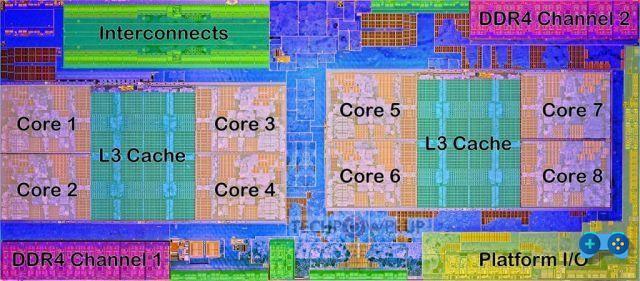
Each core in the CCX can be disabled so that it does not share anything with its neighbor other than an 8MB block of L3 cache (unlike Bulldozer). Each core has its own dedicated second level cache of 512KB. The two CCX units that are part of the Ryzen 7 communicate with each other through the high-speed interconnect system called Infinity Fabric, which we will talk about in the next paragraph. The die design and the scalability of Infinity Fabric, as we will see, have allowed AMD to adapt its offer immediately for the entry level market with the Ryzen 3 up to the super powerful Threadripper, whose top of the range is a processor with 16 cores and 32 threads with the absurd amount of 64 PCI-E lanes.
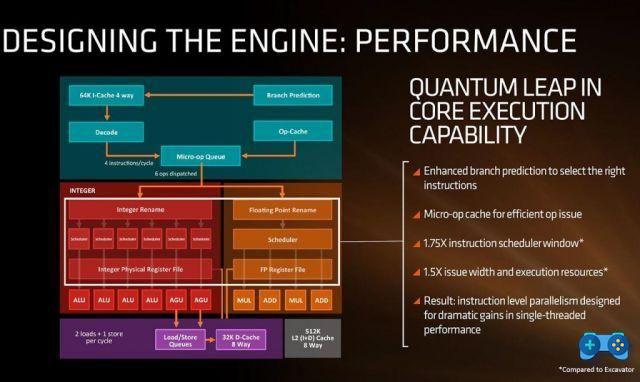
Infinity Fabric and SenseMI, let's start from technology.
The rebirth of AMD, which rises like a phoenix from its ashes, lasted four very long years during which the company developed two of the ideas that will accompany us in the future of the AMD brand, namely Infinity Fabric e SenseMI.
Before talking about Infinity Fabric, however, it is necessary to make a premise onHyperTransport, the Front Side Bus according to AMD. HT can be thought of as the highway that connects the various IC units, allowing them to communicate with each other. Unlike the FSB of the Intel processors, which is designed for each of the processors in a specific way, the HyperTransport is not only open source but it is also much more flexible, so much so that it can also be used on processors of different families. Infinity Fabric represents the evolution of the concept of flexibility imagined by AMD, in fact the Hyper Transport 2.0 will bring this communication system to be used not only on the entire range of Ryzen processors, from 7 to 3, but also on the upcoming range of Vega GPU.
Infinity Fabric will allow one bus scalability from 30 to 50 GBps for notebooks and up to 512GBps for Vega GPUs and can be used for virtually any future implementation of AMD technologies. It will also allow you to implement SenseMI technologies, which we will talk about later, and others such as the exploitation of all the DRAM present both for the SoC and for the GPUs on any product developed around the Infinity Fabric. This also affects the efficiency of the design. By guaranteeing cache coherence even in the event of an increase in the number of processors or cores in a CPU or GPU, with the only bandwidth limit, Infinity Fabric will allow you to scale up or down the design of products in a few hours without spend additional time, resources and human capital on the operation. This will also translate into much lower prices for AMD products in the future and a greater offer, capable of adapting to every market need.
SenseMI, truly intelligent processors.
The turning point of AMD processors, however, is played around the technology that the company defines SenseMI.
SenseMI is a set of learning and adapting features that help Ryzen processors deliver adequate performance for each of the areas of use, pushing the processor clock when raw power is needed or saving power when tasks don't require more power.
AMD Zen architecture leverages more than 1000 sensors to measure machine stats with delta ranging up to 1mA, 1Mv and 1 ° C. In this way the processors can enjoy a voltage that varies in real time, also modifying the operating frequencies.
Specifically, AMD divides these features into four macro areas: Pure Power, Precision Boost, eXtended Frequency Range (XFR) e Neural Net Prediction (or Smart Prefetch).
Let's analyze them in detail:
Pure Power
It is the smart sensor system that constantly monitors the processor and the system, controlling the absorption of resources, energy and temperatures, regulating everything as efficiently as possible.
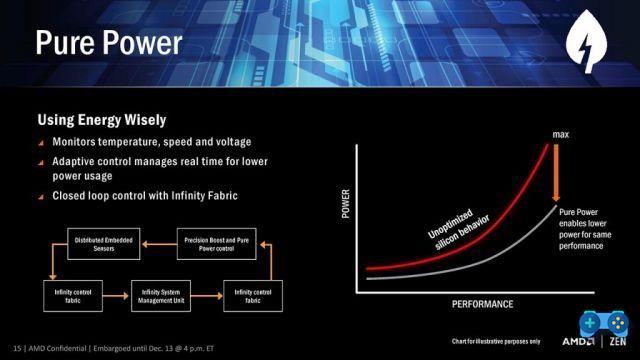
Precision Boost
Precision Boost adjusts the power / performance curve in a similar way to competing Intel Turbo Boost. Using its sensors, Ryzen is able to increase the processor frequency clock by 25 MHz and up to 100 MHz (only on X-series CPUs, while normal ones will have a boost of "only" 50 Mhz) the frequency clock of the processor when applications require.

XFR
Linked to previous technology is one of the great innovations of Summit Ridge architecture. The eXtended Frequency Range allows the processor to dynamically change the clock frequency based on operating temperatures. It is a technology that, in short, evaluates your cooling system, be it air, liquid and even LN2 and regulates the functioning of the processor. Therefore, for an AMD Ryzen machine that works at its best, a cooling system as effective as possible is essential.
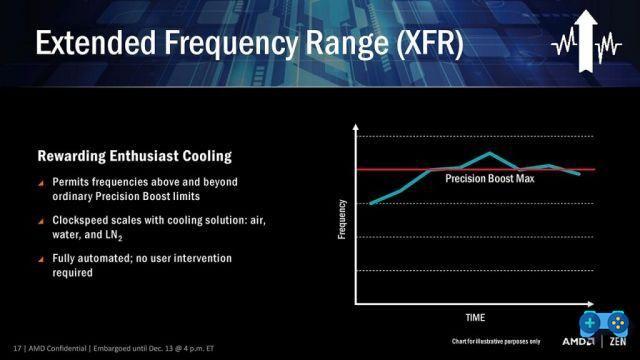
Neural Net Prediction or Smart Prefetch
It is a completely new technology that is the result of AMD's research in the field of artificial intelligence and that also brings a real neural network to consumer processors. The operation is, at least on paper, simple. The processor builds a map of the instructions and behavior of applications, requests made to the CPU, and user behaviors, preloading instructions before they are needed. This helps significantly reduce application run times, improving overall machine performance from time to time.
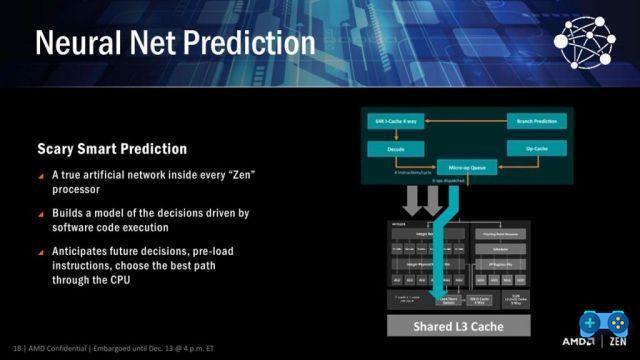
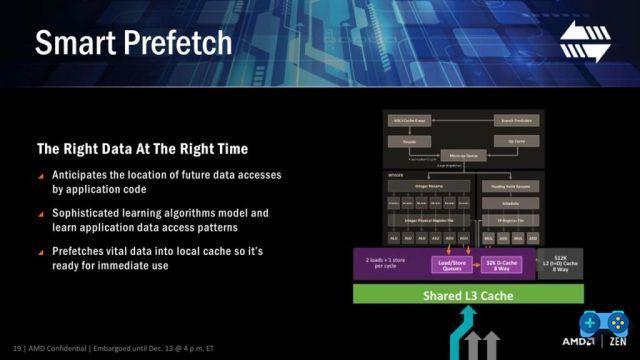
A "Prosumer" processor
Despite the integration of some technologies that could be part of a "PRO" processor, such as the Smart Prefetch and the presence of 8 SMT cores, the Ryzen 7 architecture remains mainly an architecture dedicated to the consumer and enthusiast world, leaving the task of satisfy the deepest desires of core fetishists at the upcoming Threadripper. As proof of his “prosumer” vocation we can mention the presence of “Sole” 24 PCIe lanes, 16 of which dedicated to the GPU. By choosing the most advanced solution and also the only one that allows SLI or Crossfire, the platform X370 chipset, the 16 lines dedicated to the graphics processor are divided into two connections of 8 lines each. The other lines remain free for NVMe disks and other input mapper platforms. In short, the choice is in line with that made by Intel with its Z170 and Core i7 7700K chipsets (although the company also offers an enhanced version of the platform, the Z270 with 24 PCIe lanes and an Extreme or Enthusiast version, such as the Broadwell-E , with 40 lines).
To tell the truth, the reason why you should opt, at least on the consumer / gaming / light editing market, for a system with more than 16 lines is obscure to us, also considering that for the most powerful graphics cards currently on the market, the Pascal from NVIDIA, SLI of more than two GPUs is not recommended; but you know, in this field it is often a race to "who has more, more."
New processor, new socket
After years of honorable service, AM3 has finally retired. With Ryzen, in fact, there is also a new socket that AMD intends to accompany us for a long time. The new socket AM4 however, it is very different from competing solutions. With AM4, AMD pushed hard integration by merging Northbridge and Southbridge into the CPU; in doing so, it created, in essence, an architecture much more similar to that of a SoC than to that of a traditional processor. It is the Ryzen processor that manages all the operations and divides the performance between the CPU and Southbridge, while the socket directly manages the memory, for the first time DDR4, PCIe, USB 3.0 and two SATA 6Gb / s. The chipset, in the traditional sense, is still present but only serves to add more connectivity such as more SATA ports, USB 3.1 and more PCIe lanes.
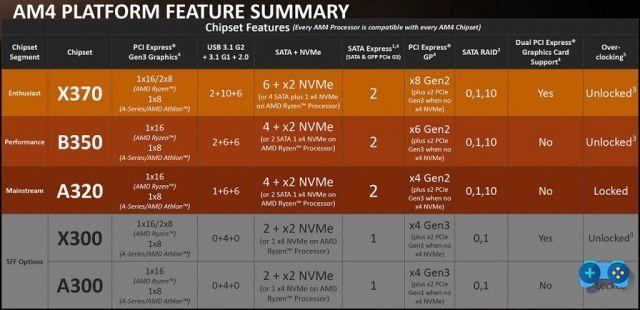
Being a SoC architecture, the differences between the different platforms are rather limited. In any case, the AM4 range is divided into five products: X370 e B350 represent the solutions for the enthusiast band. Between the two chipsets, the only difference is the presence of more PCIe lanes to support NVIDIA's SLI multi GPU architectures and AMD's Crossfire and more auxiliary connectivity.
Both manage overclocking according to the features implemented by the different motherboard manufacturers, making it possible to take advantage of the unlocked multiplier of the entire Ryzen 7 processor family. necessarily turn to "K" products to have the opportunity to overclock your processor.
The chipset A320 it is instead dedicated to the low end of the market, with a basic solution that does not allow overclocking. There are also family cards X300 e A300 which, however, do not have a real additional chipset, but the connectivity options are only those provided by the SoC in the way we have seen.
The Ryzen range
As we explained in the previous paragraphs, the great surplus of the Zen project is scalability. Thanks to Infinity Fabric, AMD is able to change and adapt its commercial offer to almost every pocket and thanks to this possibility, the Ryzen range immediately appeared very articulated.
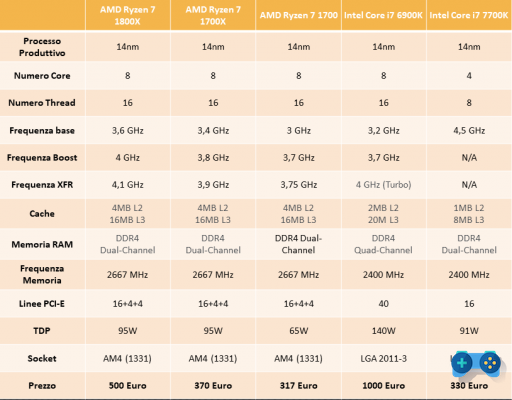 Already with a Ryzen 7 1700 at about 300 euros it is possible to take home an 8-core processor, while with 500 euros you can opt for the top of the range, always eight cores, of the Ryzen 7 family. For the equivalent processor at Intel, or the Intel i7 6900k it is necessary to spend around 1000 euros, for performances that, although superior in single thread, will hardly be a valid reason to spend twice as much the price of the top of the AMD range.
Already with a Ryzen 7 1700 at about 300 euros it is possible to take home an 8-core processor, while with 500 euros you can opt for the top of the range, always eight cores, of the Ryzen 7 family. For the equivalent processor at Intel, or the Intel i7 6900k it is necessary to spend around 1000 euros, for performances that, although superior in single thread, will hardly be a valid reason to spend twice as much the price of the top of the AMD range.
Our configuration
AMD 1800X
Before giving space to ours benchmarking and about the possibilities offered by overclocking, it is necessary to say a few words on the platform used.
For our test we used a gaming machine built ad hoc to be able to make the most of the potential of the top of the range Ryzen 1800X; in essence, we tried to optimize the choice of components by making the most of each of them.
Here are its features in the final version.
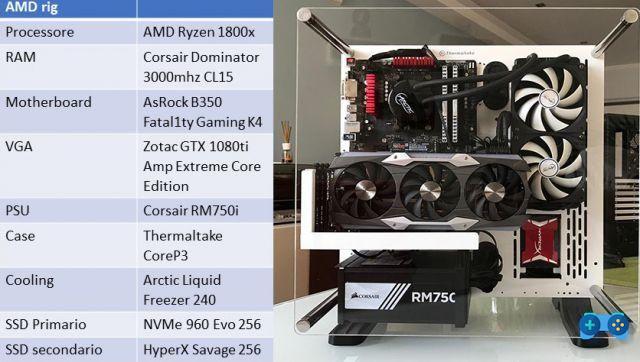
First of all we chose an AsRock motherboard based on the B350 “chipset”, the AsRock Fatal1ty AB350 Gaming K4. For those who do not intend to carry out an SLI, choosing an X370 is in most cases an ancillary expense that can instead be diverted to other components such as, in fact, more performing memories. A B350 card, also given the reduced functionality of the "chipset", is more than enough to meet the needs of 90% of users, while the AsRock in question is among the best cards in terms of OC possibilities.
Returning to the memories, the performance of Ryzen, as we will see in the benchmarks, more than any other processor tested so far is affected by the speed of the system memory. However, choosing the right ones is no easy feat. Although in recent times the situation has been improving, a series of incompatibilities mainly due to poor coordination between motherboard manufacturers and AMD has prevented us from fully exploiting the potential of the most advanced DDR4. On the net, however, lists of Ryzen compatible memories capable of achieving higher speeds and improved timings have begun to appear in some discussion groups. Among the most updated we find this appearance on reddit, but also provided by AMD directly. In general it is good to always check on the manufacturer's website which memories are compatible with your motherboard and at what speed. If the memories are not compatible, in fact, you will find yourself forced to stay on a speed of 2133 MHz if you don't want to run into system crashes, general instability and so on.
For this test we tried two types of memory, the Corsair Vengeance LPX (CMK16GX4M2B3000C15) equipped with Hynix and le modules Corsair Dominator 3000 MHz CL15 (CMD16GX4m2b3000C15); both memories are equipped with single rank modules, which should guarantee higher clock speeds. In both cases, however, the motherboard was unable to recognize speeds above 2667 MHz. While in the first case, however, we were able to keep the system stable only with very high timings, in the case of the Dominators, equipped with Samsung modules. BDIE, the only ones that guarantee a high compatibility with the Agesa BIOS, while not exceeding the frequency of 2667 MHz we managed to lower the timings a lot, up to reaching the CL13 or 14 sweetspot with practically identical performance between the two timings.
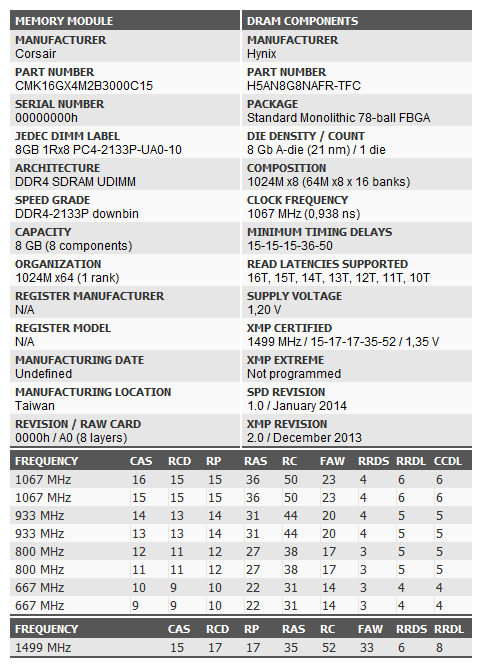
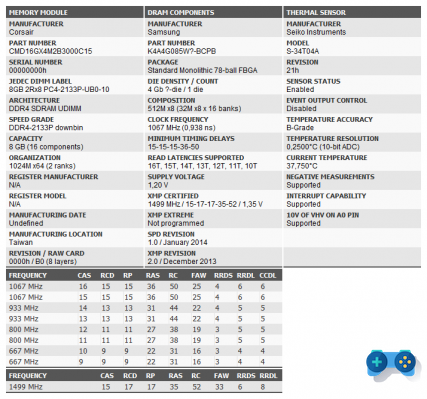
To date, if we exclude the FlareX by G.Skill, the only ones to be certified for Ryzen processors, the memories on the market are not yet able to recognize the "AMP", the AMD equivalent of XMP. Before buying your modules, therefore, our advice is to take a tour on the page we have reported to you and keep an eye on the motherboard manufacturer page and for any updates to the AGESA BIOS.
We then used a record NVMe Samsung 960 Evo to test the performance with PCIe disks, and for the reasons that we have reported in the descriptive part of the Ryzen architecture, an AIO cooling system, theArctic Liquid Freezer 240.
Benchmarks
I stability and benchmark tests were performed using the latest software versions available Aida64 Engineer Edition, Cinebench R15 (vers. 0.38), GeekBench, PCMark 11. The performance in the graphics field was measured, as well as obviously with the games we will tell you below, also with 3Dmark which is able to offer us a pretty clear picture of how Ryzen will make with DirectX12 thanks to TimeSpy. FiremarkExteme, on the other hand, is a litmus test regarding the yield with DirectX11.
With Crystal Disk Mark and Atto Disk Benchmark we instead measured the performance with NVMe disks, a task that in the Zen platform is passed to the processor.
Mozilla Kraken 1.1 instead gives us an indication of the web rendering capabilities, an important indicator to judge the general functionality of the system.
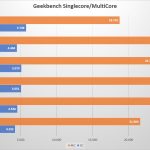
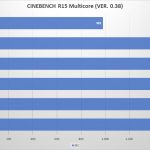

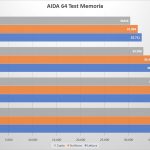
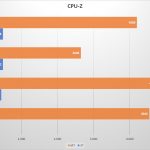
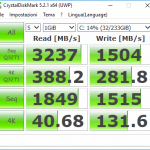
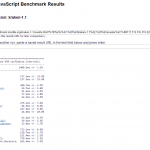
Ryzen in game
On the gaming side we used rather difficult titles both for the load on the GPU and for that on the CPU, or The Witcher 3 and GTA V, and the latter in particular is a particularly hard nut to crack for the AMD platform.
From the analysis of the data we were able to detect, especially on The Witcher 3, how the frame rate of the game is affected more than on any other platform by the speed of the RAM memory, with a variation of even 10 FPS in the passage from the frequency 2133 MHz to 2667 MHz. More than on the maximum results, however, which in real life leave the time they find, the real improvement we have observed in the average frame rate which has become much more stable , unequivocally testifying how the Ryzen platform prefers very fast memories. This is thanks to the Infinity Fabric Bus system, which as clarified by AMD is significantly influenced by the speed of the RAM and by the timings.
This data is also useful for another consideration. The Ryzen platform is still in its infancy and, as clarified in the previous paragraphs of this review, there are still many uncertainties of the motherboard manufacturers with the fastest memories. In recent months, however, the frequency of BIOS updates has been increasing and although with still mixed results, we are beginning to see marked improvements especially in optimization and compatibility. In other words, the development margins of the Ryzen ecosystem are really high and the impression is that so far we have only begun to lift the lid.
Among the titles used for the tests, GTA V it is perhaps the one that puts the processor under stress the most. In all situations, the Ryzen 7 1800X is flawless, demonstrating great stability even in the average frame rates.
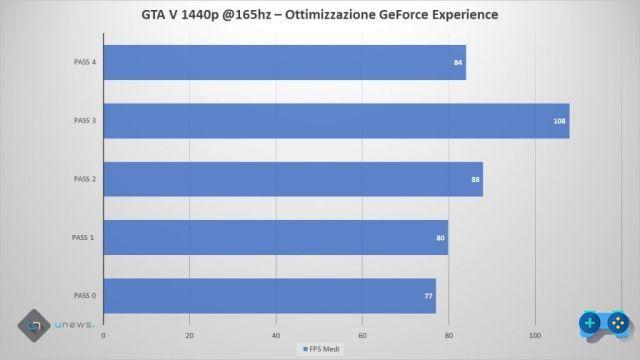
The Witcher 3 it is particularly interesting for the purposes that interest us here, because it is the confirmation of what we have also verified in the test with AIDA64. The performance of the 1800X and, in general, of all the products of the Ryzen 7 family are influenced in a decisive way by the speed of the memories. While on other products like Intel's 7700K this difference is much less marked (probably due to the high frequency of this processor), on Ryzen using memory with high frequency and low timings is a must. Too bad that, to date, the support is not yet perfect for all manufacturers.
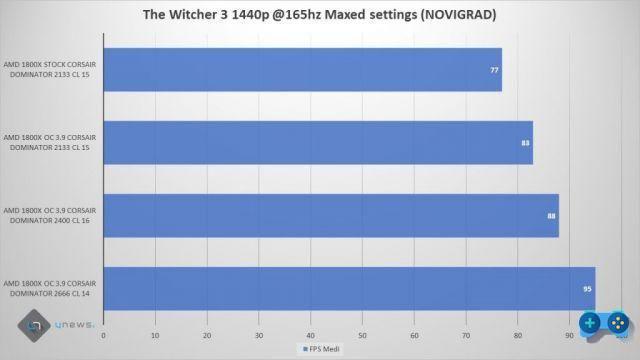
DOOM is another interesting title not so much for the medium frequencies, which on both tested processors are more than good, but rather because it demonstrates the behavior of Ryzen with API also optimized to take advantage of the large computing capacity of the 8 cores such as Vulkan. Again, Ryzen comes out the winner in both maximum and medium FPS.
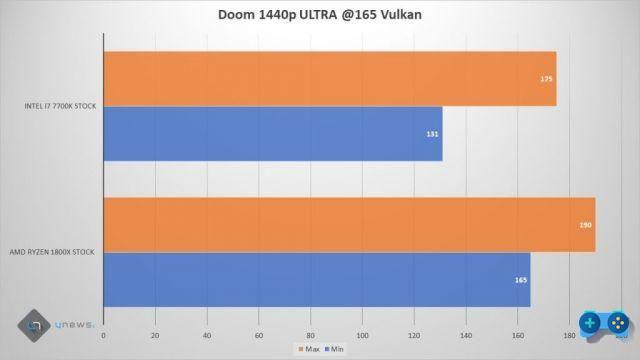

Hitman it was one of the most complicated titles for the processor under consideration in its early days. Now that the platform is decidedly more mature, Hitman's results show us that the Ryzen 1800X is a processor that is also suitable for gaming. Of course, its rival 7700K has a street price of almost 100 euros lower, but if you also combine gaming with production activities in which you can take advantage of the additional cores, they are certainly money well spent.
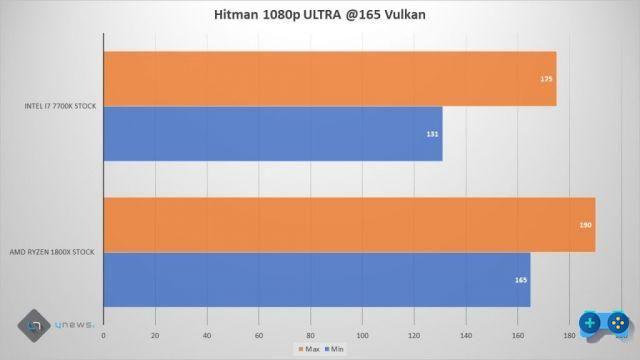
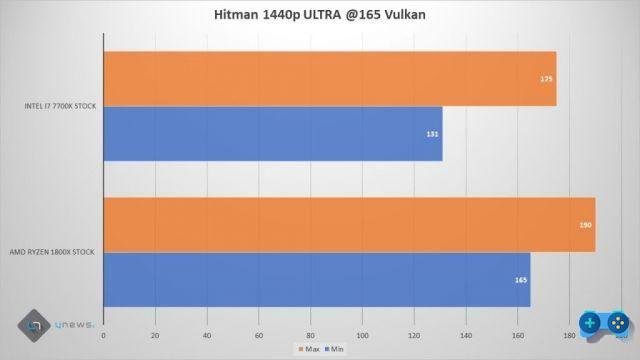
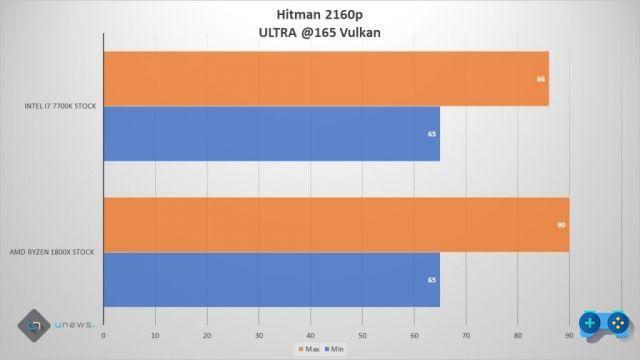
Overclocking 1800X and temperatures
AMD with Ryzen 7 has implemented a policy, if you will, risky. Unlike what happens in the Intel world, where to access the unlocked multipliers it is necessary to turn to the processors with the initials K, spending significantly more, AMD with Ryzen has decided to offer this possibility on the entire 7 range. The choice on the commercial level might seem counterproductive since many, according to market information that we were able to find on the net, instead of opting for the more expensive but more performing processors in the "stock" version, have decided to opt for the more expensive model. economic, except to recover something by venturing, in many for the first time, with the OC. A behavior that even AMD seems to encourage by providing users with a truly intuitive software such as Ryzen Master.
In the first months of life, precisely by virtue of this possibility, one of the users' favorite processors was precisely the 1700, the entry level of the 7 family which, when overclocked, manages to guarantee performance only slightly lower than a 1800X, with a price difference, however, that varies between 150 and 200 euros.
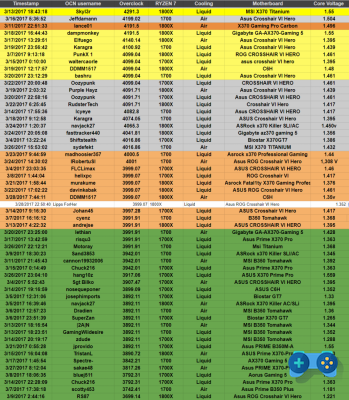
The table above (which you can find complete at this link) indicates the average overclocking values of the Ryzen range, and although the data certainly cannot be considered scientific (also because it was drawn up by enthusiasts and therefore by aware users), it is useful to give you an idea of what the family 7 is capable of doing and what consumer choices have been.
How does the 1800X perform?
AMD seems to have already pulled the 1800X to the maximum and, at least with our example equipped on a B350, we have not been able to go beyond 3900 Mhz, even pushing the voltage to the maximum to 1.45v. A good result but certainly not impressive. A little something can be recovered by deactivating the SMT on the BIOS side, but this is a trick that makes little sense in terms of real use of the machine since by deactivating the SMT the performance in the most common applications drops significantly.
With a multiplier of 39 consumption in full load is around 129W in total package compared to 95W in the stock version, performance increases significantly with a percentage increase that reaches 30% in more frequency sensitive programs and in games. The temperatures, on the other hand, are absolutely more than regular, never exceeding 57 ° in the AIDA64 stresstest and reaching 61 ° in PRIME95 and SuperPI (all tests were carried out with a controlled ambient temperature of 24 °).
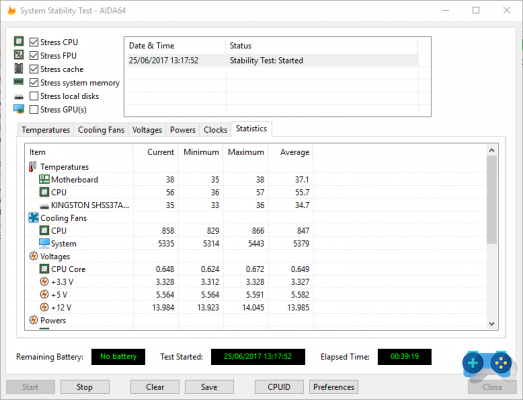
Conclusions and judgment
With the family of Ryzen processors, AMD is seriously troubling the arch rival Intel both from a technological point of view and from a commercial and image point of view. Let's start with the first; Ryzen 1800X, it is useless to hide it, is an exceptional product, loaded as it is with technological innovations that have been missing for too long in the technological landscape now flattened by Intel's "Tick / Tock" policy. The technologies of the SenseMI package play an important role in performance, but it is the possibility of having 8 cores available to make the difference. This performance difference is certainly certified by the multithreading scores recorded by our CPU (the result in CinebenchR15 is crazy), but it is also tangible in daily use. Rendering a video while playing, streaming, leaving programs with a heavy load on the CPU in the background while continuing to work on other software, and generally multitasking without feeling the slightest uncertainty, is something that can only be done thanks to to a multi core processor and in this Ryzen 7 1800x it is perfect.
The difference compared to the products offered by Intel is that today these possibilities are accessible to a drastically wider range of people, thanks to a price that is almost 1/3 compared to that of the same Intel grade. And this brings us to the second point, the commercial factor. With a price as highly competitive as the 1800x it will be difficult to find any form of justification for buying Intel machines. Especially considering that with the same price as a SkylakeX in a few weeks it will be possible to buy the Threadripper 1950X with 16 cores and 32 threads, or the 1920X with 12 cores and 24 threads.
Of course, the platform is still very unripe and a certain "inexperience" cannot be overlooked, we do not know very well attributable to who and to AMD or to motherboard manufacturers in managing the compatibility of RAM memories, which as we have said profoundly affects performance processor, however also from a commercial point of view AMD has moved very well, offering the image of a company reborn from its ashes with an exceptional project and low cost, which has made all of a sudden the image of the competitor, guilty of "pulling it out" a little too much, especially with prices.
One thing, however, is certain: the road is clear, AMD is back and we couldn't be happier.





